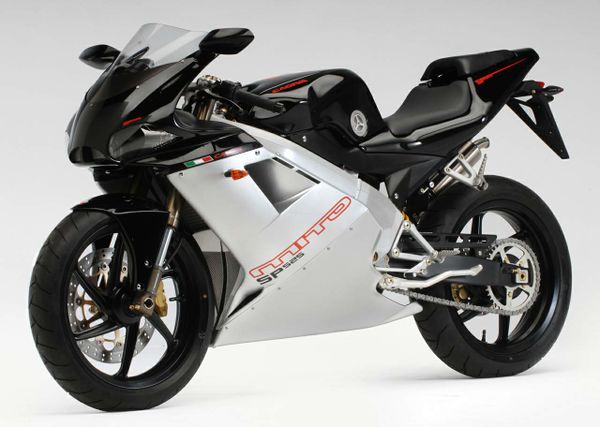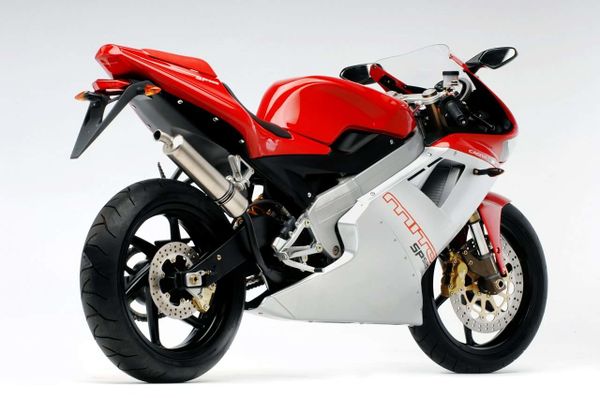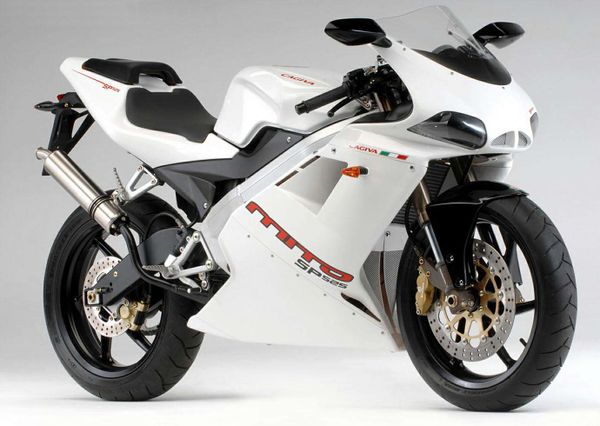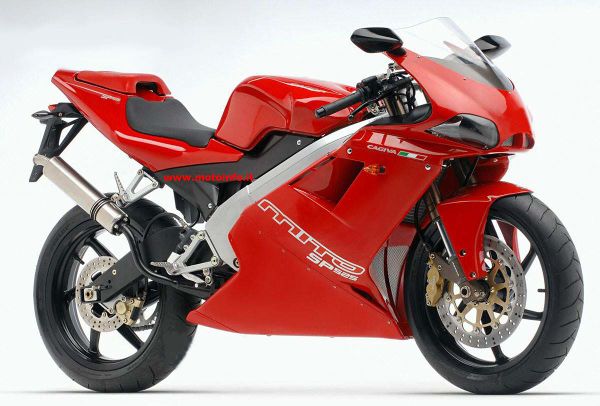Cagiva Mito SP524
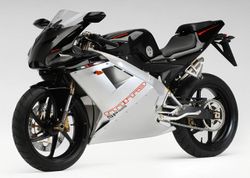 |
|
| Cagiva Mito SP524 | |
| Manufacturer | |
|---|---|
| Production | 2008 - 09 |
| Engine | Two stroke, single cylinder, electric variable power read valve |
| Compression ratio | 7.4:1 |
| Ignition | CDI |
| Transmission | 6 Speed |
| Frame | Aluminum double extruded beam |
| Suspension | Front: 40mm Marzocchi telescopic forks Rear: Progressive with hydralyc shock, adjustable spring preload |
| Brakes | Front: Single 320mm disc 4 piston caliper Rear: Single 230mm disc 2 piston caliper |
| Front Tire | 110/70 ZR17 |
| Rear Tire | 150/60 ZR17 |
| Wheelbase | 1375 mm / 54.1 in |
| Seat Height | 760 mm / 29.9 in |
| Weight | 129.0 kg / 284.4 lbs (dry), |
| Fuel Capacity | 14 Liters / 3.7 US gal |
| Manuals | Service Manual |
Engine[edit | edit source]
The engine was a Liquid cooled cooled Two stroke, single cylinder, electric variable power read valve. The engine featured a 7.4:1 compression ratio.
Drive[edit | edit source]
Power was moderated via the Wet, multiple discs, cable operated.
Chassis[edit | edit source]
It came with a 110/70 ZR17 front tire and a 150/60 ZR17 rear tire. Stopping was achieved via Single 320mm disc 4 piston caliper in the front and a Single 230mm disc 2 piston caliper in the rear. The front suspension was a 40mm Marzocchi telescopic forks while the rear was equipped with a Progressive with hydralyc shock, adjustable spring preload. The Mito SP524 was fitted with a 14 Liters / 3.7 US gal fuel tank. The bike weighed just 129.0 kg / 284.4 lbs. The wheelbase was 1375 mm / 54.1 in long.
Photos[edit | edit source]
Overview[edit | edit source]
Cagiva Moto SP525
Cagiva is proud to have been able to change what
a being "two-stroke engine" means and to have been able to blend the new
technology into the Mito 125. The research and investments made by Cagiva, mean
that those days when the words "two stroke" implied only great performance are
finally gone. They now also mean caring for the environment.
The integrated ECS (Electronic Carburetion System) administers exactly the right amount of fuel (both the air/petrol and oil mix) and was developed in collaboration with DellOrto. The control unit also governs the ignition system. While keeping costs under control and sales prices competitive, this brings the two-stroke 125 engine to Euro 3 standards, yet maintains all the advantages that two-stroke engines can offer: lightness, performance and low running costs.
MCN road testers give their verdict on the
latest 125 racer-replicas
Honda CBR125R For many years Honda's CBR125R was the perfect way to through your bike test. It was cheap, uber reliable, modern and easy to ride. But if youve got money to burn, the Honda is hopelessly outclassed.
Five years ago the CBR was fresh and sporty, but today, even with funky HRC color scheme and gold wheels, it looks are comparable to the best of cheap Chinese imports. Sorry Honda, but thats how it is when compared to the illustrious company its trying to hang with.
And its horribly under-tyred the front tires on the other three bikes have more girth than the Hondas rear and the IRC supplied rubber borders on Teflon coated. Chasing the others theres a king-sized sensation of feebleness from the front brake, forks and chassis.
The Hondas simple liquid-cooled, fuel-injected engine performs with the same brutal efficiency of any Honda engine. No matter how badly you abuse it, like a faithful, slabbering Labrador it will do what its told until old age takes its toll.
CBR125R Review
This is the modern equivalent of the CBR125R. It has big bike looks, ride quality and styling which all come together to give its rider a glimpse of whats in store after a full licence has been granted. But while we all like the Yamaha, there are two other bikes that deliver the same pleasures with greater purity.
Styled around Rossis dominant M1, the Yamaha is, for want of a better word, sharp. Its modern look will snare todays new riders because its so recognisable.
The Yamaha engine is strong but gives no real indication of what it is doing. It could be the same engine from the Honda just with a tad more top end performance from its four-valve engine. It gets to 60mph fairly easily, struggles a little to hit 70mph and then after that every 1mph on top is a bonus.
The main difference between the Yamaha and Honda motors is the Yamaha will pull 70mph all day, whereas the Hondas top two gears see considerably more action uphill and into headwinds.
A tall tail section/pillion perch gives the impression the Yamaha has a considerably taller seat height than it actually has. At 818mm high the Yamahas seat is only 42mm taller than the Honda. But where the Hondas rear shock collapses at the mention of someone riding it, the Yamahas remains composed to retain its bigger bike ride quality. Of which there is plenty. It could be the wide bars, spacious seating position and overall build quality.
The downside is the Yamaha lacks ride quality. We mean theres very little feedback from the front end so you never know how close to the limit the front tire is. Or how hard you can really corner when emulating racing greats, which is how anyone acts when sat on a bike made to look as if it can cut it. But I guess we are nit-picking here. Yamahas YZF-R125 lifted MCNs 2008 award for Best Sports bike Under 600cc and with good reason it is good.
YZF-R125 Review
But there is something better for 2009.
Aprilia RS125R Todays crop of racer-replica 125s are extremely desirable none more so than the Aprilia with its superb braking and rigid chassis. The Aprilias polished frame and race bodywork are as effective as Viagra in pumping blood round my tired body.
Old agrees with young once more when it comes to two-stroke over four-stroke power. Aprilias RS125 is a very, very polished performer. From the moment the electronic dash flickers into life and the engine starts with familiar smell of a cold two-stroke on choke, the RS125 tells you fun is coming your way.
Unfortunately, the unmistakable rasp of a crisp engine is short lived when cold. It coughs, splutters and struggles to pull cleanly until thoroughly warmed. But even when that time comes and the bikes given its head, the way the tacho needle limply seeps past 8000rpm is greatly disturbing. It doesnt need us to remind you this bikes Rotax-supplied engine is restricted to meet legal requirements.
Even so, there is still a step in the powerband to excite anyone. Its this burst of performance after 7000rpm even though it is mechanically and electrically neutered that makes a stunningly created 125cc machine even better.
RS125R Review
Cagiva Mito 525 The new Cagiva is similar. Revived from under the wing of MV Agusta, the Mito dates back to 1989, undergoing several makeovers over the interim before reappearing now as the Mito 525. Along with a new Euro 3 emissions compliant engine, it has a new look paying homage to the C594 two-stroke GP500 bikes of Mamola and Lawson. This makes it arguably the sweetest looking 125cc machine out there.
But it is also the most tractable of the two strokers easily keeping with the Yamaha in the first two gears before pulling ahead. Its the corner exit throttle control that makes the Mito more thrilling than the Aprilia. Not because theres a bigger jump in power delivery, but because its a smoother delivery. The Aprilia cracks into go fast mode because the engine revs have to be higher to get the desired drive, whereas the Mito rushes forward with precise throttle input.
Ok I know were talking about piddly 125cc machines that make hard work of carrying a 15-stone rider let alone a pillion, but every little bit of pleasantness helps the performance of a restricted 125. This also includes the chassis and running gear around it.
Decent screen height, usable mirrors and ergonomics meant the old duffers again chose the Mito over the youngsters choice of the Aprilia.
Mito 525 Review
Verdict The two-stroke Aprilia and Cagiva beat their four-stroke rivals in all but practicality. They are intense machines that demand nothing less than 95% concentration and 100% skill to wring the most out of them. Which one is the best for you is difficult to say: both are brilliant and both can be derestricted to release their full potential (approx 21bhp for the Aprilia, 25bhp for the Cagiva). This means not having to buy another bike to make use of the 33bhp allowed during the regulation two-year probation period. The young irresponsible mind inside this old body says go for the Cagiva...
| Make Model | Cagiva Mito SP 525 |
|---|---|
| Year | 2008 - 09 |
| Engine Type | Two stroke, single cylinder, electric variable power read valve |
| Displacement | 125.6 cc / 7.6 cu-in |
| Bore X Stroke | 56 x 50.6 mm |
| Cooling System | Liquid cooled |
| Compression | 7.4:1 |
| Induction | Dell'Orto PHBH 25 carburetor |
| Ignition | CDI |
| Starting | Electric |
| Max Power | 25.4 hp / 18.9 kW @ 12000 rpm |
| Max Torque | 23 Nm / 16.9 lb-ft @ 11000 rpm |
| Clutch | Wet, multiple discs, cable operated |
| Transmission | 6 Speed |
| Final Drive | Chain |
| Frame | Aluminum double extruded beam |
| Front Suspension | 40mm Marzocchi telescopic forks |
| Front Wheel Travel | 120 mm / 4.7 in |
| Rear Suspension | Progressive with hydralyc shock, adjustable spring preload |
| Rear Wheel Travel | 133 mm / 5.4 in |
| Front Brakes | Single 320mm disc 4 piston caliper |
| Rear Brakes | Single 230mm disc 2 piston caliper |
| Front Tire | 110/70 ZR17 |
| Rear Tire | 150/60 ZR17 |
| Dimensions | Height 1070 mm / 42.1 in Length 1980 mm / 78.0 in |
| Wheelbase | 1375 mm / 54.1 in |
| Seat Height | 760 mm / 29.9 in |
| Ground Clearance | 150 mm / 5.9 in |
| Dry Weight | 129.0 kg / 284.4 lbs |
| Fuel Capacity | 14 Liters / 3.7 US gal |
